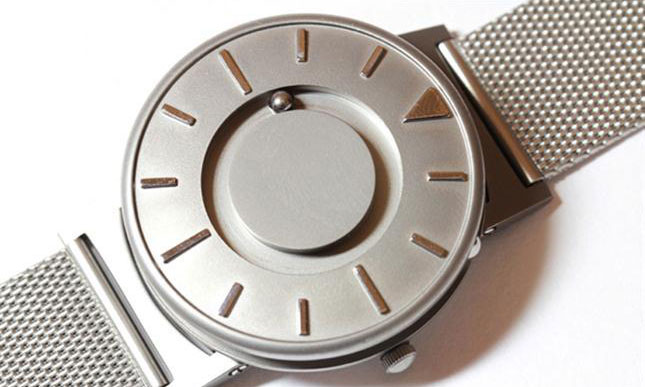You Probably Don't Understand Watches
If you dislike the Apple Watch, sorry to hear that. Now, let us show you some other watches you definitely can't afford.
$5,612

Why Rolex doesn't outsource stuff
Here's the thing that makes Apple different from Rolex corporately.
Apple uses dozens of contractors like Foxconn to make the various parts that ultimately show up in your laptop or phone. It's an approach that generally works out OK, though there are cases where the whole damn mess breaks down.
Rolex, however, is a 100 percent vertically integrated company, meaning they make everything that shows up in their watches, from the steel to the quartz.
Like Apple, they do things that on the surface seem absurd—like making an extremely expensive kind of steel because it looks a little better—but play perfectly into their no-compromises strategy.
Ariel Adams, an expert on luxury timepieces, says this kind of M.O. flows through the whole corporation.
"Imagine a spaceship flying through space on a very serious mission,"he wrote for Forbes back in 2013. "The spaceship even has people on-board who can improve the ship while it is in motion. When the spaceship left earth it was told that it had a sole mission, to travel as far into space as possible. That is kind of like Rolex."
The move towards vertical integration is relatively recent: in the 1990s, the Switzerland-based company decided to slowly start moving in this direction. But it was only in 2012, when the company opened a factory in Bienne (shown above), when it managed to fulfill this mission.
But beyond this whole vertical-integration thing, it makes sense to compare Apple and Rolex. As the Financial Times notes, Rolex is famous for being incredibly secretive, just like Apple is. And like Steve Jobs, Rolex founder Hans Wilsdorf had an obsession with greatness that topped low prices most of the time.
“It is not with low prices but, on the contrary, it is with improved quality that we can not only hold the market but improve,” Wilsdorf wrote in 1912.
Rolex regularly sells watches that cost more than Macbooks. So maybe it makes sense that Apple wants a piece of that market.
Five watches more expensive than the Apple Watch Edition
- If you have a friend who owns a Jaeger-LeCoultre Hybris Mechanica à Grande Sonnerie, there's a good chance your friend was born into money. The watch, which chimes just like Big Ben, costs $1,474,070.
- The Greubel Forsey Art Piece 1 includes a tiny sculpture of a ship inside of its crown. It'll put you back about $1.5 million.
- Some of Graham's Chronofighter watches—notable for the trigger-style crown on the side—dip below the $10,000 mark, but if you want them in gold, you'll be paying more than that.
- When swinging around a racquet, Rafael Nadal generally wears a $690,000 watch. The watch maker Richard Mille makes a watch specifically for Nadal, and two others specifically for Jackie Chan.
- The Patek Philippe Calatrava tops the $10k mark of the lowest-cost Apple Watch. Arguably, though, the Apple Watch has more gold going on.

Here's a watch worth respecting, no matter your price range
If we can't necessarily sell you on the idea that the Apple Watch Edition is about average in the context of the watch that it's competing with, perhaps we can at least tell you about a freaking awesome watch that costs less than an Apple Watch Sport—but has a pretty awesome angle to it.
The startup EONE got its start back in 2013, when it launched its timepiece on Kickstarter. The watch looks rather snazzy, but what makes it really impressive is that it's designed for an audience that tends not to be remembered by most watchmakers—those who can't see.
The EONE Bradley, named for paralympic swimmer Bradley Snyder, uses magnets to tell time—and does well at it. If you move the magnets, they move back into place, in a way that's easy to follow if you can't see them. And here's the best part: If you can see the watch, you'd have no idea that it was designed for the visually impaired. It looks so snazzy that just 1 to 2 percent of its buyers are within its initial target audience.
“You don’t need to come up with a whole new technology to serve minorities,” Eone founder Hyungsoo Kim said in an interview with_Technical.ly_ earlier this year.
And it's a price that most people can afford, too—the high-end modeltops out at a still-cheaper-than-an-Apple-Watch-Sport $315.
I don't really have a horse in this race. I've only owned one or two watches in my life—given to me as gifts—and they've never really been a big deal for me like they are for some people. (I do have a Jawbone—also a gift—which I find to be useful.)
But the problem that I see with the way that people have gone insane over the Apple Watch in recent days is something of perspective. I'm not saying that Apple necessarily is making many friends by selling a watch that costs more than some people make in a year—but that it's merely working within the context of an already established product sector.
"Consider: Apple, with its $650 cellphones and $1,500 computers, already makes perhaps the fifth or sixth most expensive item in a high-income household, right behind furniture, luxury goods, TV’s, cars, and homes. And guess what? They’re now in the luxury goods business," Wired writer Cliff Kuang wrote this week.
We don't have to like the fact that watches cost this much. We don't have to like the fact that Apple now makes watches this expensive. But can we appreciate that we may not in fact be the target audience for this bling—and that's no reason to hate it?
:format(jpeg)/2018/01/tedium031215.gif)
/2018/01/tedium031215.gif)

/uploads/ernie_crop.jpg)